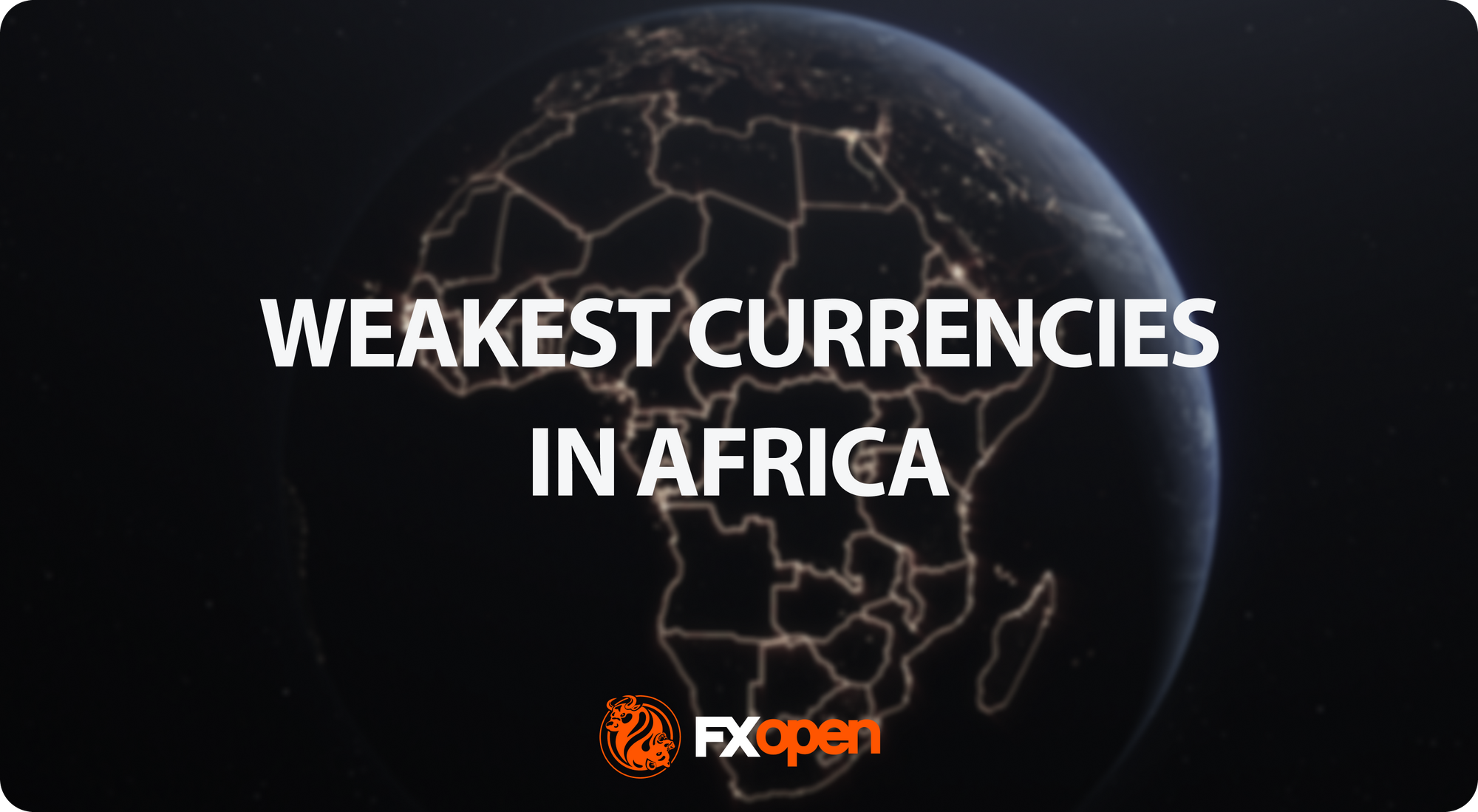FXOpen

Currencies reflect the health of a nation’s economy, and several African nations continue to grapple with severe depreciation. From dependence on commodity exports to political unrest and chronic inflation, each case tells a different story of economic struggle.
This FXOpen article examines what are considered to be the lowest currencies in Africa, highlighting the structural challenges behind their weakness and the risks they face in global markets.
The List of 10 Currencies That Are Considered the Weakest in Africa
Currency weakness in Africa stems from many different pressures, including inflation, external debt, reliance on imports, and fragile governance. Each country faces a unique mix of structural challenges that influence exchange rate performance and investor confidence.
In the sections below, we look at the top 10 currencies that are considered the weakest in Africa, exploring the economic and political forces that drive depreciation. To provide consistency, the US dollar serves as the benchmark that offers direct comparisons of how these currencies trade on the global market.
*The rates are effective on the 17th of September, 2025.
10. Rwandan Franc (RWF)
Exchange rate: 1 RWF = 0.000691 USD
Rwanda has made some progress in recent years, but its currency, the Rwandan franc, continues to face challenges. Rwanda is working to diversify its economy but faces obstacles such as its landlocked geography and dependence on agriculture. The country relies heavily on imports, which makes it vulnerable to fluctuations in the global market. The depreciation of the Rwandan franc fuels inflationary pressures as import prices surge. Rwanda struggles with persistent shortages of foreign exchange reserves, which also limit economic growth.
9. Nigerian Naira (NGN)
Exchange rate: 1 NGN = 0.00067 USD
The naira has lost significant value following multiple devaluations and the removal of fuel subsidies in 2023–24. Dollar shortages, a large import bill, and heavy debt servicing costs keep pressure on the currency. As of August 2025, inflation remains above 20%, eroding purchasing power. Despite reforms aimed at unifying exchange rates and boosting investment, foreign currency scarcity and structural reliance on oil revenues continue to undermine the country’s stability.
8. Malawian Kwacha (MWK)
Exchange rate: 1 MWK = 0.000577 USD
Malawian kwacha is the national currency of Malawi, which is a landlocked country in southeastern Africa. Malawi’s economy depends on agriculture, which employs more than 80% of the population. Low agricultural productivity and limited commercialisation lead to stagnant income growth for most Malawians. The country struggles with limited diversification and is vulnerable to external shocks like weather events.
7. Tanzania Shilling (TZS)
Exchange rate: 1 TZS = 0.000405 USD
Economic development in Tanzania is uneven, with challenges such as corruption, underdeveloped infrastructure, and limited industrialisation. Tanzania is dependent on imports, which contributes to the country’s weak economy and currency. Despite the recent robust expansion in exports, primarily fueled by the resurgence of tourism, the increased growth in imports driven by domestic demand, coupled with escalating international commodity prices, led to a broadening of the current account deficit (CAD).
6. Congolese Franc (CDF)
Exchange rate: 1 CDF = 0.000361 USD
The Congolese franc is used in the Democratic Republic of Congo (DRC). Similar to Tanzania and Rwanda, the DRC is heavily dependent on imports. The country is rich in natural resources but struggles with corruption and conflicts, which restrict economic development. Political instability plays a significant role in the country’s economic issues. The currency’s exchange rate is also influenced by foreign exchange reserves, which remain low.
5. Burundian Franc (BIF)
Exchange rate: 1 BIF = 0.000335 USD
Burundi’s economy is dealing with numerous challenges. The country is not economically diversified; its economy is based mainly on agriculture. The export base of Burundi is limited and concentrated in a few key commodities, gold, coffee, and tea. The country relies significantly on foreign aid. The BIF currency rate is impacted by recurring political instability. These crises have a detrimental impact on economic stability and erode confidence in the BIF.
4. Ugandan Shilling (UGX)
Exchange rate: 1 UGX = 0.000285 USD
Uganda’s economy faces multiple challenges, particularly its dependence on agriculture and the slow pace of industrialisation. The dependency on agriculture makes the country especially vulnerable to fluctuations in commodity prices and weather conditions. Uganda generally runs a negative trade balance, importing more than it exports. This puts pressure on the exchange rate of the Ugandan shilling.
3. Malagasy Ariary (MGA)
Exchange rate: 1 MGA = 0.000227 USD
The Malagasy ariary is the currency of Madagascar. It is a weak currency due to a number of factors, including import dependency and high inflation. Madagascar’s economy is in crisis, and the national currency continues to depreciate at an alarming rate. The country experiences political instability. Economic growth is hampered by limited foreign investment, a weak business climate, and infrastructure development problems.
2. Guinean Franc (GNF)
Exchange rate: 1 GNF = 0.000115 USD
Guinea, like some other countries in the region, experiences economic difficulties. Guinea has large reserves of natural resources, including bauxite, but faces challenges in fully capitalising on them. Political instability hinders economic development. Guinea’s economy is susceptible to external shocks like fluctuations in global commodity prices, particularly in the mining sector. In addition, security concerns, including border disputes and regional tensions, disrupt economic activities and lower investor confidence.
1. Sierra Leonean Leone (SLL)
Exchange rate: 1 SLL = 0.0000437 USD
The Sierra Leonean leone is cited as the weakest currency in Africa. The leone has been negatively affected by high inflation, economic weaknesses, and substantial debt burdens. Since 1 July 2022, the currency has been abbreviated as the SLE due to the redenomination of the old leone (SLL) at an exchange rate of 1,000 SLL to 1 SLE. The current rate of 1 SLE to USD is 0.0437.
Final Thoughts
This list of so-called weak African currencies highlights how structural weaknesses, policy decisions, and external shocks shape exchange rates. From fragile institutions to overreliance on commodities, these challenges illustrate why some nations struggle to stabilise their financial systems. Yet Africa also offers vast potential, with natural resources, demographic growth, and emerging industries pointing towards a bright future for the continent.
Traders often focus on liquid, major pairs with higher volatility. To participate in global markets, you can consider opening an FXOpen account and access tight spreads, low commissions, and advanced charting through the TickTrader trading platform.
FAQ
Which Currency Is Considered the Weakest in Africa in 2025?
The Sierra Leonean leone is often labelled as the weakest currency in Africa in 2025, trading at roughly 1 SLL = 0.0000438 USD. Persistent inflation, high debt, and structural vulnerabilities have led to a perception of being the least valuable currency in Africa, despite government efforts to stabilise finances and rebuild confidence.
Which Country Is Believed to Have the Highest-Value Currency in Africa?
Tunisia is considered to have Africa’s strongest currency, with the Tunisian dinar trading at about 1 TND = 0.34 USD. Despite economic challenges, relative policy stability and stronger demand for the dinar support its higher valuation compared with other African currencies in 2025.
Which Currency Is Used in South Africa?
The primary currency in South Africa today is the South African rand (ZAR). The rand is a free-floating currency influenced by global commodity prices, investor sentiment, and domestic policy. South Africa’s exchange rate is seen as one of Africa’s strongest, currently at around 0.0576 USD per 1 ZAR, and is closely tied to gold and resource exports.
Which Country Is Considered the Richest in Africa?
According to Statista, South Africa is cited as Africa’s richest country by GDP size, supported by platinum, gold, coal, and diamonds exports. However, on a per-capita basis, nations like Seychelles and Mauritius often rank higher due to smaller populations.
This article represents the opinion of the Companies operating under the FXOpen brand only. It is not to be construed as an offer, solicitation, or recommendation with respect to products and services provided by the Companies operating under the FXOpen brand, nor is it to be considered financial advice.
Stay ahead of the market!
Subscribe now to our mailing list and receive the latest market news and insights delivered directly to your inbox.








